Jana Diesner
Revisiting gender bias research in bibliometrics: Standardizing methodological variability using Scholarly Data Analysis (SoDA) Cards
Jan 30, 2025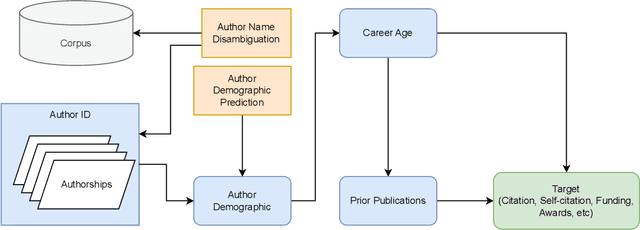

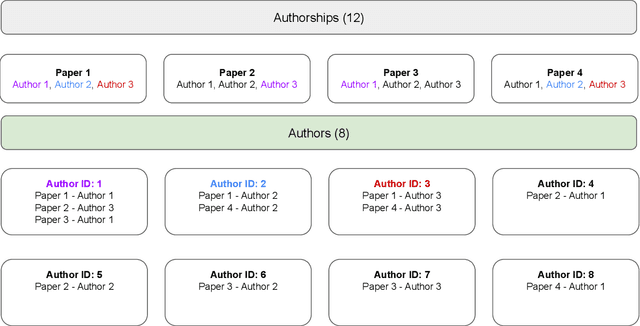

Abstract:Gender biases in scholarly metrics remain a persistent concern, despite numerous bibliometric studies exploring their presence and absence across productivity, impact, acknowledgment, and self-citations. However, methodological inconsistencies, particularly in author name disambiguation and gender identification, limit the reliability and comparability of these studies, potentially perpetuating misperceptions and hindering effective interventions. A review of 70 relevant publications over the past 12 years reveals a wide range of approaches, from name-based and manual searches to more algorithmic and gold-standard methods, with no clear consensus on best practices. This variability, compounded by challenges such as accurately disambiguating Asian names and managing unassigned gender labels, underscores the urgent need for standardized and robust methodologies. To address this critical gap, we propose the development and implementation of ``Scholarly Data Analysis (SoDA) Cards." These cards will provide a structured framework for documenting and reporting key methodological choices in scholarly data analysis, including author name disambiguation and gender identification procedures. By promoting transparency and reproducibility, SoDA Cards will facilitate more accurate comparisons and aggregations of research findings, ultimately supporting evidence-informed policymaking and enabling the longitudinal tracking of analytical approaches in the study of gender and other social biases in academia.
Examining Alignment of Large Language Models through Representative Heuristics: The Case of Political Stereotypes
Jan 27, 2025



Abstract:Examining the alignment of large language models (LLMs) has become increasingly important, particularly when these systems fail to operate as intended. This study explores the challenge of aligning LLMs with human intentions and values, with specific focus on their political inclinations. Previous research has highlighted LLMs' propensity to display political leanings, and their ability to mimic certain political parties' stances on various issues. However, the extent and conditions under which LLMs deviate from empirical positions have not been thoroughly examined. To address this gap, our study systematically investigates the factors contributing to LLMs' deviations from empirical positions on political issues, aiming to quantify these deviations and identify the conditions that cause them. Drawing on cognitive science findings related to representativeness heuristics -- where individuals readily recall the representative attribute of a target group in a way that leads to exaggerated beliefs -- we scrutinize LLM responses through this heuristics lens. We conduct experiments to determine how LLMs exhibit stereotypes by inflating judgments in favor of specific political parties. Our results indicate that while LLMs can mimic certain political parties' positions, they often exaggerate these positions more than human respondents do. Notably, LLMs tend to overemphasize representativeness to a greater extent than humans. This study highlights the susceptibility of LLMs to representativeness heuristics, suggeseting potential vulnerabilities to political stereotypes. We propose prompt-based mitigation strategies that demonstrate effectiveness in reducing the influence of representativeness in LLM responses.
MEXA: Multilingual Evaluation of English-Centric LLMs via Cross-Lingual Alignment
Oct 08, 2024Abstract:English-centric large language models (LLMs) often show strong multilingual capabilities. However, the multilingual performance of these models remains unclear and is not thoroughly evaluated for many languages. Most benchmarks for multilinguality focus on classic NLP tasks, or cover a minimal number of languages. We introduce MEXA, a method for assessing the multilingual capabilities of pre-trained English-centric LLMs using parallel sentences, which are available for more languages than existing downstream tasks. MEXA leverages the fact that English-centric LLMs use English as a kind of pivot language in their intermediate layers. It computes the alignment between English and non-English languages using parallel sentences to evaluate the transfer of language understanding from English to other languages. This alignment can be used to estimate model performance in other languages. We conduct studies using various parallel datasets (FLORES-200 and Bible), models (Llama family, Gemma family, Mistral, and OLMo), and established downstream tasks (Belebele, m-MMLU, and m-ARC). We explore different methods to compute embeddings in decoder-only models. Our results show that MEXA, in its default settings, achieves a statistically significant average Pearson correlation of 0.90 with three established downstream tasks across nine models and two parallel datasets. This suggests that MEXA is a reliable method for estimating the multilingual capabilities of English-centric LLMs, providing a clearer understanding of their multilingual potential and the inner workings of LLMs. Leaderboard: https://huggingface.co/spaces/cis-lmu/Mexa, Code: https://github.com/cisnlp/Mexa.
SciPrompt: Knowledge-augmented Prompting for Fine-grained Categorization of Scientific Topics
Oct 02, 2024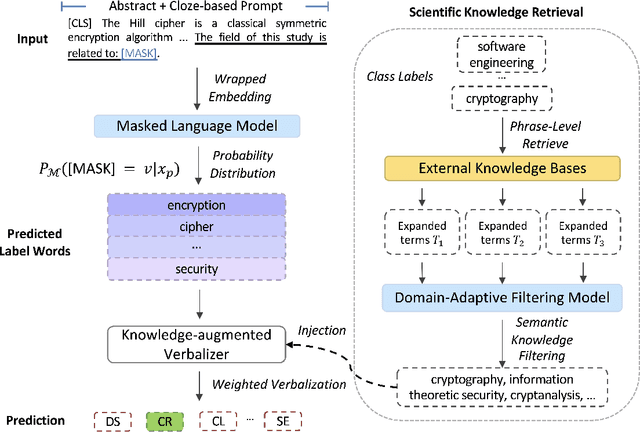
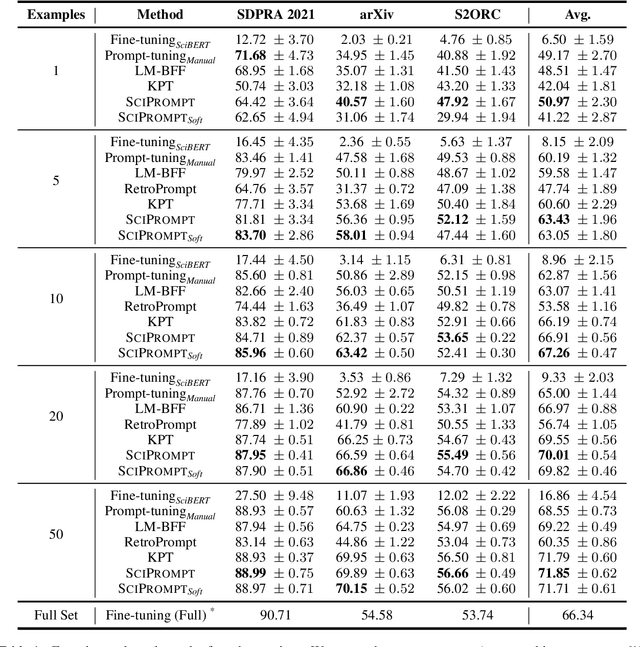

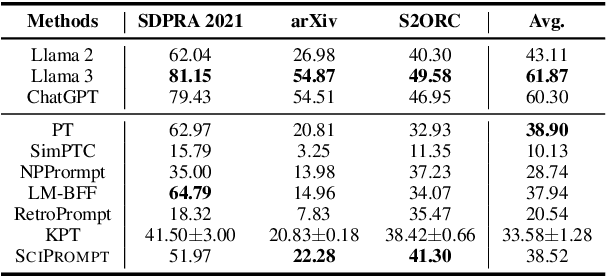
Abstract:Prompt-based fine-tuning has become an essential method for eliciting information encoded in pre-trained language models for a variety of tasks, including text classification. For multi-class classification tasks, prompt-based fine-tuning under low-resource scenarios has resulted in performance levels comparable to those of fully fine-tuning methods. Previous studies have used crafted prompt templates and verbalizers, mapping from the label terms space to the class space, to solve the classification problem as a masked language modeling task. However, cross-domain and fine-grained prompt-based fine-tuning with an automatically enriched verbalizer remains unexplored, mainly due to the difficulty and costs of manually selecting domain label terms for the verbalizer, which requires humans with domain expertise. To address this challenge, we introduce SciPrompt, a framework designed to automatically retrieve scientific topic-related terms for low-resource text classification tasks. To this end, we select semantically correlated and domain-specific label terms within the context of scientific literature for verbalizer augmentation. Furthermore, we propose a new verbalization strategy that uses correlation scores as additional weights to enhance the prediction performance of the language model during model tuning. Our method outperforms state-of-the-art, prompt-based fine-tuning methods on scientific text classification tasks under few and zero-shot settings, especially in classifying fine-grained and emerging scientific topics.
Beyond Binary Gender Labels: Revealing Gender Biases in LLMs through Gender-Neutral Name Predictions
Jul 07, 2024Abstract:Name-based gender prediction has traditionally categorized individuals as either female or male based on their names, using a binary classification system. That binary approach can be problematic in the cases of gender-neutral names that do not align with any one gender, among other reasons. Relying solely on binary gender categories without recognizing gender-neutral names can reduce the inclusiveness of gender prediction tasks. We introduce an additional gender category, i.e., "neutral", to study and address potential gender biases in Large Language Models (LLMs). We evaluate the performance of several foundational and large language models in predicting gender based on first names only. Additionally, we investigate the impact of adding birth years to enhance the accuracy of gender prediction, accounting for shifting associations between names and genders over time. Our findings indicate that most LLMs identify male and female names with high accuracy (over 80%) but struggle with gender-neutral names (under 40%), and the accuracy of gender prediction is higher for English-based first names than non-English names. The experimental results show that incorporating the birth year does not improve the overall accuracy of gender prediction, especially for names with evolving gender associations. We recommend using caution when applying LLMs for gender identification in downstream tasks, particularly when dealing with non-binary gender labels.
StereoMap: Quantifying the Awareness of Human-like Stereotypes in Large Language Models
Oct 31, 2023Abstract:Large Language Models (LLMs) have been observed to encode and perpetuate harmful associations present in the training data. We propose a theoretically grounded framework called StereoMap to gain insights into their perceptions of how demographic groups have been viewed by society. The framework is grounded in the Stereotype Content Model (SCM); a well-established theory from psychology. According to SCM, stereotypes are not all alike. Instead, the dimensions of Warmth and Competence serve as the factors that delineate the nature of stereotypes. Based on the SCM theory, StereoMap maps LLMs' perceptions of social groups (defined by socio-demographic features) using the dimensions of Warmth and Competence. Furthermore, the framework enables the investigation of keywords and verbalizations of reasoning of LLMs' judgments to uncover underlying factors influencing their perceptions. Our results show that LLMs exhibit a diverse range of perceptions towards these groups, characterized by mixed evaluations along the dimensions of Warmth and Competence. Furthermore, analyzing the reasonings of LLMs, our findings indicate that LLMs demonstrate an awareness of social disparities, often stating statistical data and research findings to support their reasoning. This study contributes to the understanding of how LLMs perceive and represent social groups, shedding light on their potential biases and the perpetuation of harmful associations.
Examining the Causal Effect of First Names on Language Models: The Case of Social Commonsense Reasoning
Jun 01, 2023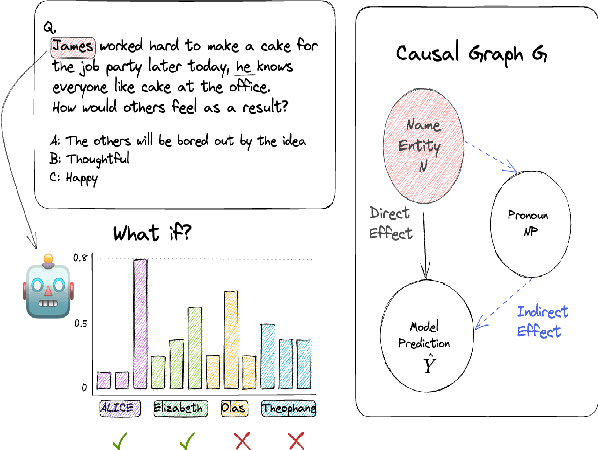
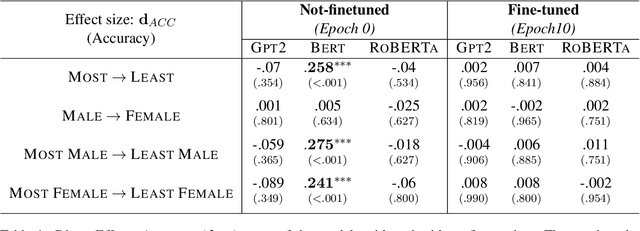

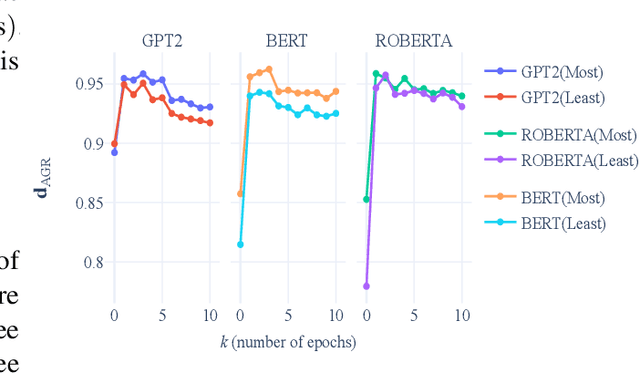
Abstract:As language models continue to be integrated into applications of personal and societal relevance, ensuring these models' trustworthiness is crucial, particularly with respect to producing consistent outputs regardless of sensitive attributes. Given that first names may serve as proxies for (intersectional) socio-demographic representations, it is imperative to examine the impact of first names on commonsense reasoning capabilities. In this paper, we study whether a model's reasoning given a specific input differs based on the first names provided. Our underlying assumption is that the reasoning about Alice should not differ from the reasoning about James. We propose and implement a controlled experimental framework to measure the causal effect of first names on commonsense reasoning, enabling us to distinguish between model predictions due to chance and caused by actual factors of interest. Our results indicate that the frequency of first names has a direct effect on model prediction, with less frequent names yielding divergent predictions compared to more frequent names. To gain insights into the internal mechanisms of models that are contributing to these behaviors, we also conduct an in-depth explainable analysis. Overall, our findings suggest that to ensure model robustness, it is essential to augment datasets with more diverse first names during the configuration stage.
PyTAIL: Interactive and Incremental Learning of NLP Models with Human in the Loop for Online Data
Nov 24, 2022



Abstract:Online data streams make training machine learning models hard because of distribution shift and new patterns emerging over time. For natural language processing (NLP) tasks that utilize a collection of features based on lexicons and rules, it is important to adapt these features to the changing data. To address this challenge we introduce PyTAIL, a python library, which allows a human in the loop approach to actively train NLP models. PyTAIL enhances generic active learning, which only suggests new instances to label by also suggesting new features like rules and lexicons to label. Furthermore, PyTAIL is flexible enough for users to accept, reject, or update rules and lexicons as the model is being trained. Finally, we simulate the performance of PyTAIL on existing social media benchmark datasets for text classification. We compare various active learning strategies on these benchmarks. The model closes the gap with as few as 10% of the training data. Finally, we also highlight the importance of tracking evaluation metric on remaining data (which is not yet merged with active learning) alongside the test dataset. This highlights the effectiveness of the model in accurately annotating the remaining dataset, which is especially suitable for batch processing of large unlabelled corpora. PyTAIL will be available at https://github.com/socialmediaie/pytail.
What Changed? Investigating Debiasing Methods using Causal Mediation Analysis
Jun 01, 2022
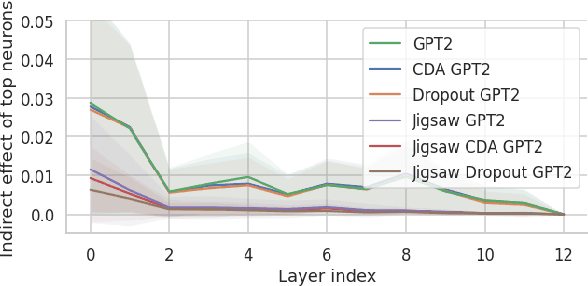
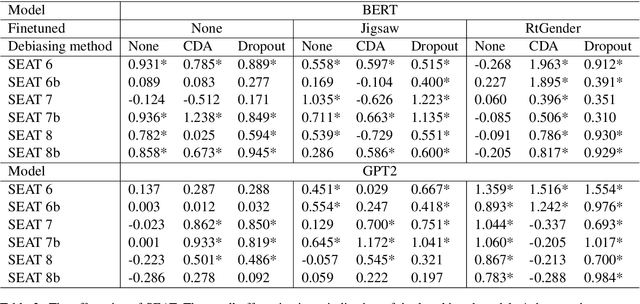
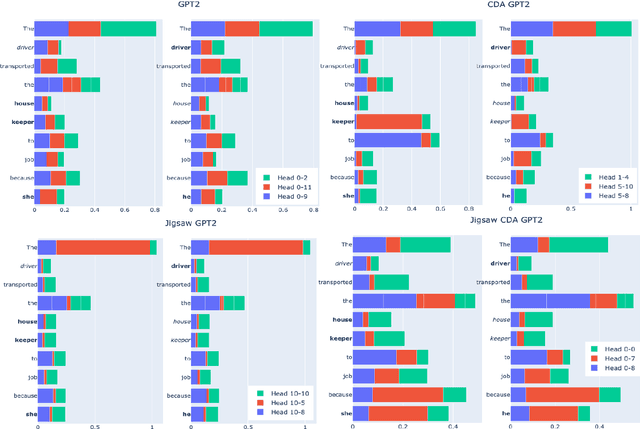
Abstract:Previous work has examined how debiasing language models affect downstream tasks, specifically, how debiasing techniques influence task performance and whether debiased models also make impartial predictions in downstream tasks or not. However, what we don't understand well yet is why debiasing methods have varying impacts on downstream tasks and how debiasing techniques affect internal components of language models, i.e., neurons, layers, and attentions. In this paper, we decompose the internal mechanisms of debiasing language models with respect to gender by applying causal mediation analysis to understand the influence of debiasing methods on toxicity detection as a downstream task. Our findings suggest a need to test the effectiveness of debiasing methods with different bias metrics, and to focus on changes in the behavior of certain components of the models, e.g.,first two layers of language models, and attention heads.
What should I Ask: A Knowledge-driven Approach for Follow-up Questions Generation in Conversational Surveys
May 23, 2022


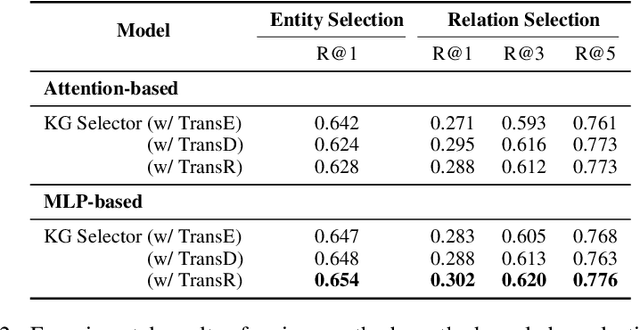
Abstract:Conversational surveys, where an agent asks open-ended questions through natural language interfaces, offer a new way to collect information from people. A good follow-up question in a conversational survey prompts high-quality information and delivers engaging experiences. However, generating high-quality follow-up questions on the fly is a non-trivial task. The agent needs to understand the diverse and complex participant responses, adhere to the survey goal, and generate clear and coherent questions. In this study, we propose a knowledge-driven follow-up question generation framework. The framework combines a knowledge selection module to identify salient topics in participants' responses and a generative model guided by selected knowledge entity-relation pairs. To investigate the effectiveness of the proposed framework, we build a new dataset for open-domain follow-up question generation and present a new set of reference-free evaluation metrics based on Gricean Maxim. Our experiments demonstrate that our framework outperforms a GPT-based baseline in both objective evaluation and human-expert evaluation.
 Add to Chrome
Add to Chrome Add to Firefox
Add to Firefox Add to Edge
Add to Edge